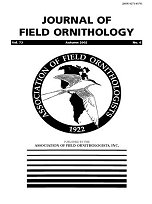We studied the reproductive biology of a population of Blue-fronted Amazons (Amazona aestiva) in the Pantanal of Mato Grosso do Sul State, Brazil, between 1997 and 1999. Nesting occurred from August to December. We monitored 94 nests which were found in trees of different sizes. Nesting trees were distributed in all major vegetation associations (floodplains, grasslands, scrub savanna, savanna, arboreal savanna, riparian forests, and pastures). We found about half of nests (53%) in an open and disturbed area of 34 km2, yielding a density of 0.5 nests/km2. In the remaining 486 km2 of the study area, we estimated a mean density of 0.03 nests/km2. This could reflect preferences towards open and anthropic-influenced habitats or simply visibility bias. We found most of the nests in Palmae, Leguminosae, and Bignoniaceae, but the proportion of successful nests did not differ between tree types. Average clutch size varied little among the three years of study, but nest survival and the proportion of fledglings per female were lower in 1998 than in 1997 and 1999. The cause of the lower fledging success in 1998 was not determined, but deforestation, an early onset of the rainy season, and higher rates of nest visitation by researchers may have been involved.
BioOne.org will be down briefly for maintenance on 12 February 2025 between 18:00-21:00 Pacific Time US. We apologize for any inconvenience.
How to translate text using browser tools
1 October 2002
Nesting success and hatching survival of the Blue-fronted Amazon (Amazona aestiva) in the Pantanal of Mato Grosso do Sul, Brazil
Gláucia Helena Fernandes Seixas,
Guilherme de Miranda Mourão
ACCESS THE FULL ARTICLE
It is not available for individual sale.
This article is only available to subscribers.
It is not available for individual sale.
It is not available for individual sale.

Journal of Field Ornithology
Vol. 73 • No. 4
October 2002
Vol. 73 • No. 4
October 2002
Amazona aestiva
Blue-fronted Amazon
Pantanal
reproductive biology




